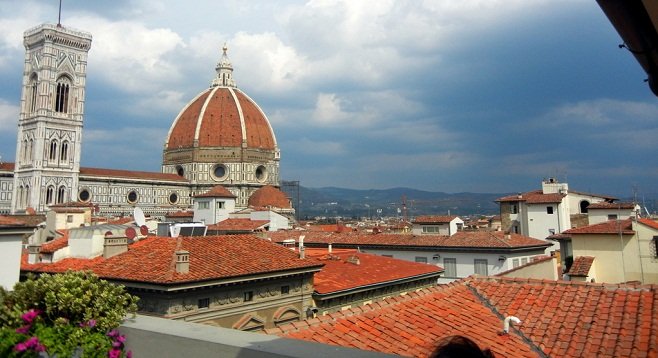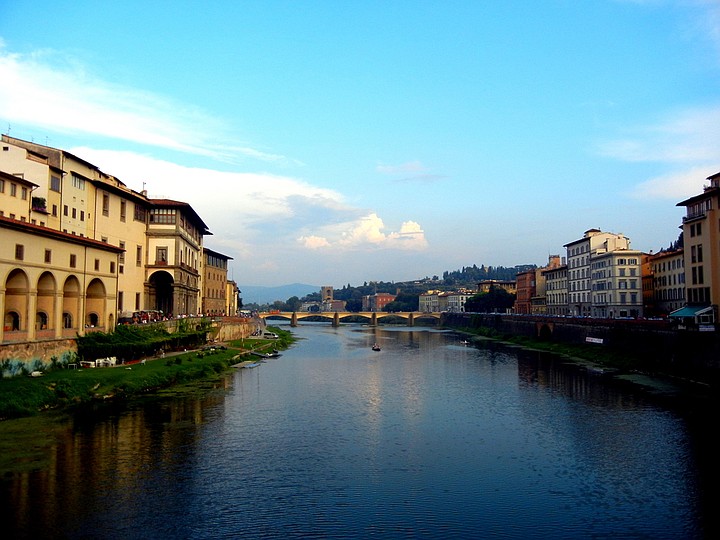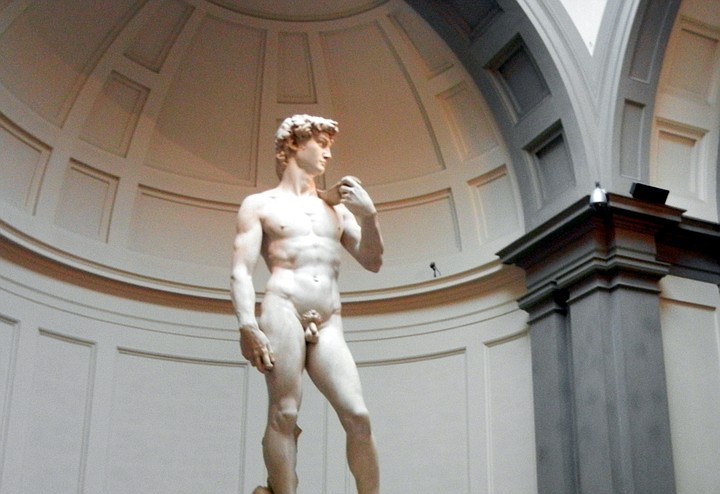 Facebook
Facebook
 X
X
 Instagram
Instagram
 TikTok
TikTok
 Youtube
Youtube

An easy 1.5-hour train ride from Rome got us into Florence midday. After gathering our bearings (and a map), we set off to drop our bags off at our flat before exploring the city.
We again stayed at an Airbnb place – this time in a villa with several of the rooms rented out by other travelers. The villa featured a lovely courtyard, kitchen and free use of bikes. The only downside was that since we weren't staying directly in the city center, we had to take the bus into the city. But after the few minutes it took to get our bearings, we found Florence's bus system easy to navigate.

Florence is quite approachable on foot, and other than taking the bus into the city in the morning and out at night, we walked everywhere else. The city is divided by the River Arno, which sections off the tourist district north of the river and some of the more hip local districts south. (This also means that we found food and shopping to be much more affordable and enjoyable south of the Arno.)
The top two sites to see in Florence are the Accademia, featuring Michelangelo’s David statue, and the Uffizi Gallery, which features hundreds of works from several renowned artists. We decided beforehand that although they had steep entry fees, we really wanted to see both museums. In both cases, it's recommended you arrive at least 30 minutes before opening; the lines can be quite long. If you're willing to fork over an extra €4 each, you can cut the lines and make a reservation for a specific time and day. In our case, we were already feeling the dent in our wallets, so we made it a point to wake up early and get in line before the crowds showed up.

When all is said and done, seeing the David was priceless and totally worth waiting in line. Once you're up close and personal with the massive statue, you begin to realize how much work it took to create this marble masterpiece, from his massive toes to his chiseled abs (pun intended). Leading up to the David, we passed Michelangelo's unfinished sculptures entitled Prisoners. The sculptures look as if they are attempting to break out of the block of stone. It's enlightening to see these pieces covered in chiseled marks set against the contrasting background of David's perfectly smooth silhouette.
Our time spent in the Accademia also reminded me that museums aren't perfect little boxes, but places where real life happens: In the 30 minutes we sat staring at the David's chiseled muscles, there were numerous sets of parents shuffling their crying children through the area in an attempt to ward off a loud tantrum but still hoping to catch a glimpse of the statue they had waited so long to see. We also overheard a story about how a madman attempted to hammer off the feet of the David in 1991. You will see that he is safely kept behind a glass barrier now (David, that is, not the madman).

After spending an educational morning at the Accademia, we walked over to the Duomo, Florence's expansive cathedral. The exterior of the cathedral is quite unique; it's covered in pieces of peach-colored marble and other various colors. However, not to be a cathedral snob, but the inside doesn't do the outside justice. After seeing the Basilica in Rome, I was expecting to find more architectural details, frescos and stone work happening on the inside of the Duomo. Instead, it was a simple, relatively unadorned wide-open space.
Feeling a rumbling in our tummies, we picked up some deliciously cheap paninos at I Fratellini for only €2.50 a piece. It's tucked on a quiet, cool side street off the main tourist area and is a great place to rest on a stoop and enjoy your lunch.
We spent the remainder of the afternoon eating gelato and wandering the rest of the city. Our friend taught us that the trick to finding the best gelato is to check the color of the banana flavor. It should be more of a gray color instead of a bright yellow. Also, if the gelato is in a stainless steel tub with a lid instead of in the oblong-shaped blocks, you know it's freshly made. A true winner in our gelato books was La Carraia, just on the corner if you cross the Arno on Ponte Carraia – scoops are a mere €1.
Another popular trend in Italy is aperitivos – or as we know it, happy hour. In short, you pay anywhere from €7-10 for a cocktail, then you can help yourself to the delicious Italian buffet. Depending on the restaurant, the spread can vary, so just peek in to see if the choices look good before you commit to having a drink.
The following day we went to the Uffizi Gallery bright and early in the morning to avoid the long lines. Despite the fact that we still had to stand in line for an hour, it was better doing it in the morning shade than the hot afternoon sun. Once inside, we were fooled by just how large the museum actually was. If you don't read or look at anything, it will take you at least 45 minutes to just walk through the maze of exhibits!
To save money, we skipped the audio tour, loaded up our free Rick Steve's audio guide for the Uffizi Gallery on our iPod, and listened as he described each room. Among the famous pieces you can find in the gallery are Leonardo da Vinci's The Annunciation and Botticelli's famous Birth of Venus. The museum even offers a special tour for blind museum-goers who want to experience the art by touch. They've created a small bas-relief of the Birth of Venus so that blind or visually impaired people can touch and feel what the painting looks like.

We spent the rest of the day peeking into old churches, consuming more gelato, and searching out artsy shops. We found one shop tucked into a small alleyway that specialized in recreating and restoring broken art pieces like sculptures and antique clocks. Peering into the windows after they had already closed, we noticed a few miniature clay busts that caught our eye. The next day, we made a special trip back to see the delicate busts and purchase a few as souvenirs. If you have to ring a shop's doorbell, pay in cash, and find out it really isn't a shop after all but someone's workshop, you know you've found yourself a deal!
On our last day, we stopped in for lunch at Il Ristoro dei Perditempo, where you can sit in the back of the cafe with the windows open and enjoy the river flowing below. It was a nice view and cool reprieve from Florence's hot weather.
As with any accommodations, there are bound to be issues that can arise. The last night of our stay in the Airbnb villa, suddenly, for unknown reasons, the water shut off. So we had five people living in a large house with no water. Thankfully our hosts brought over dozens of bottles of water for drinking, showering and using the toilet. Although it felt a bit like roughing it and we had to leave for Milan without a proper shower, it wasn't the end of the world and all part of our grand adventure.
Next up, we head to Milan!


An easy 1.5-hour train ride from Rome got us into Florence midday. After gathering our bearings (and a map), we set off to drop our bags off at our flat before exploring the city.
We again stayed at an Airbnb place – this time in a villa with several of the rooms rented out by other travelers. The villa featured a lovely courtyard, kitchen and free use of bikes. The only downside was that since we weren't staying directly in the city center, we had to take the bus into the city. But after the few minutes it took to get our bearings, we found Florence's bus system easy to navigate.

Florence is quite approachable on foot, and other than taking the bus into the city in the morning and out at night, we walked everywhere else. The city is divided by the River Arno, which sections off the tourist district north of the river and some of the more hip local districts south. (This also means that we found food and shopping to be much more affordable and enjoyable south of the Arno.)
The top two sites to see in Florence are the Accademia, featuring Michelangelo’s David statue, and the Uffizi Gallery, which features hundreds of works from several renowned artists. We decided beforehand that although they had steep entry fees, we really wanted to see both museums. In both cases, it's recommended you arrive at least 30 minutes before opening; the lines can be quite long. If you're willing to fork over an extra €4 each, you can cut the lines and make a reservation for a specific time and day. In our case, we were already feeling the dent in our wallets, so we made it a point to wake up early and get in line before the crowds showed up.

When all is said and done, seeing the David was priceless and totally worth waiting in line. Once you're up close and personal with the massive statue, you begin to realize how much work it took to create this marble masterpiece, from his massive toes to his chiseled abs (pun intended). Leading up to the David, we passed Michelangelo's unfinished sculptures entitled Prisoners. The sculptures look as if they are attempting to break out of the block of stone. It's enlightening to see these pieces covered in chiseled marks set against the contrasting background of David's perfectly smooth silhouette.
Our time spent in the Accademia also reminded me that museums aren't perfect little boxes, but places where real life happens: In the 30 minutes we sat staring at the David's chiseled muscles, there were numerous sets of parents shuffling their crying children through the area in an attempt to ward off a loud tantrum but still hoping to catch a glimpse of the statue they had waited so long to see. We also overheard a story about how a madman attempted to hammer off the feet of the David in 1991. You will see that he is safely kept behind a glass barrier now (David, that is, not the madman).

After spending an educational morning at the Accademia, we walked over to the Duomo, Florence's expansive cathedral. The exterior of the cathedral is quite unique; it's covered in pieces of peach-colored marble and other various colors. However, not to be a cathedral snob, but the inside doesn't do the outside justice. After seeing the Basilica in Rome, I was expecting to find more architectural details, frescos and stone work happening on the inside of the Duomo. Instead, it was a simple, relatively unadorned wide-open space.
Feeling a rumbling in our tummies, we picked up some deliciously cheap paninos at I Fratellini for only €2.50 a piece. It's tucked on a quiet, cool side street off the main tourist area and is a great place to rest on a stoop and enjoy your lunch.
We spent the remainder of the afternoon eating gelato and wandering the rest of the city. Our friend taught us that the trick to finding the best gelato is to check the color of the banana flavor. It should be more of a gray color instead of a bright yellow. Also, if the gelato is in a stainless steel tub with a lid instead of in the oblong-shaped blocks, you know it's freshly made. A true winner in our gelato books was La Carraia, just on the corner if you cross the Arno on Ponte Carraia – scoops are a mere €1.
Another popular trend in Italy is aperitivos – or as we know it, happy hour. In short, you pay anywhere from €7-10 for a cocktail, then you can help yourself to the delicious Italian buffet. Depending on the restaurant, the spread can vary, so just peek in to see if the choices look good before you commit to having a drink.
The following day we went to the Uffizi Gallery bright and early in the morning to avoid the long lines. Despite the fact that we still had to stand in line for an hour, it was better doing it in the morning shade than the hot afternoon sun. Once inside, we were fooled by just how large the museum actually was. If you don't read or look at anything, it will take you at least 45 minutes to just walk through the maze of exhibits!
To save money, we skipped the audio tour, loaded up our free Rick Steve's audio guide for the Uffizi Gallery on our iPod, and listened as he described each room. Among the famous pieces you can find in the gallery are Leonardo da Vinci's The Annunciation and Botticelli's famous Birth of Venus. The museum even offers a special tour for blind museum-goers who want to experience the art by touch. They've created a small bas-relief of the Birth of Venus so that blind or visually impaired people can touch and feel what the painting looks like.

We spent the rest of the day peeking into old churches, consuming more gelato, and searching out artsy shops. We found one shop tucked into a small alleyway that specialized in recreating and restoring broken art pieces like sculptures and antique clocks. Peering into the windows after they had already closed, we noticed a few miniature clay busts that caught our eye. The next day, we made a special trip back to see the delicate busts and purchase a few as souvenirs. If you have to ring a shop's doorbell, pay in cash, and find out it really isn't a shop after all but someone's workshop, you know you've found yourself a deal!
On our last day, we stopped in for lunch at Il Ristoro dei Perditempo, where you can sit in the back of the cafe with the windows open and enjoy the river flowing below. It was a nice view and cool reprieve from Florence's hot weather.
As with any accommodations, there are bound to be issues that can arise. The last night of our stay in the Airbnb villa, suddenly, for unknown reasons, the water shut off. So we had five people living in a large house with no water. Thankfully our hosts brought over dozens of bottles of water for drinking, showering and using the toilet. Although it felt a bit like roughing it and we had to leave for Milan without a proper shower, it wasn't the end of the world and all part of our grand adventure.
Next up, we head to Milan!
Comments